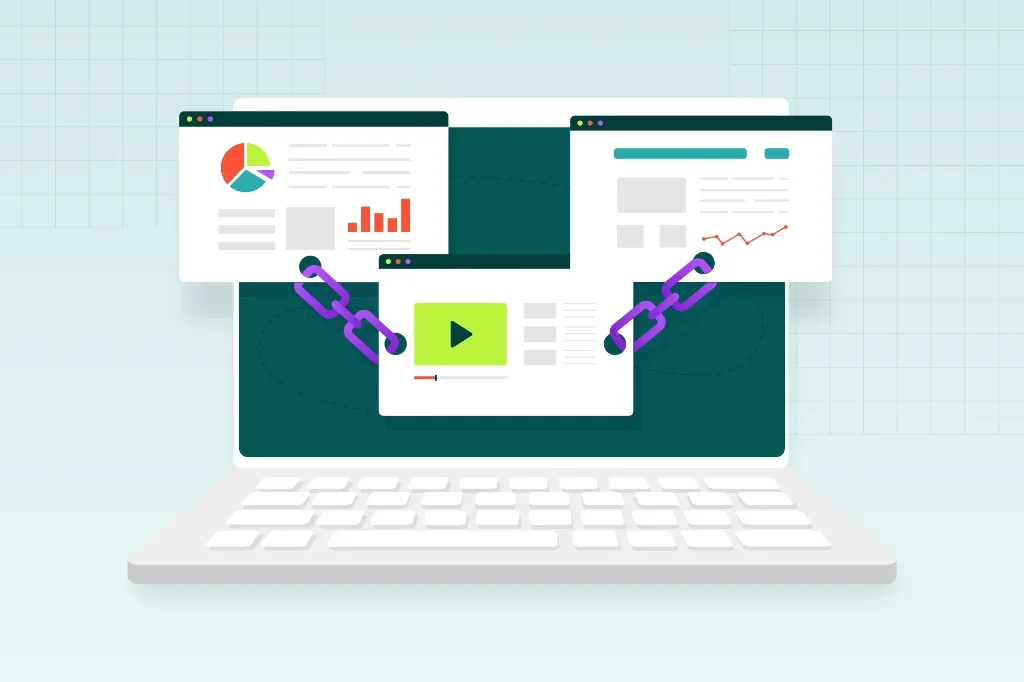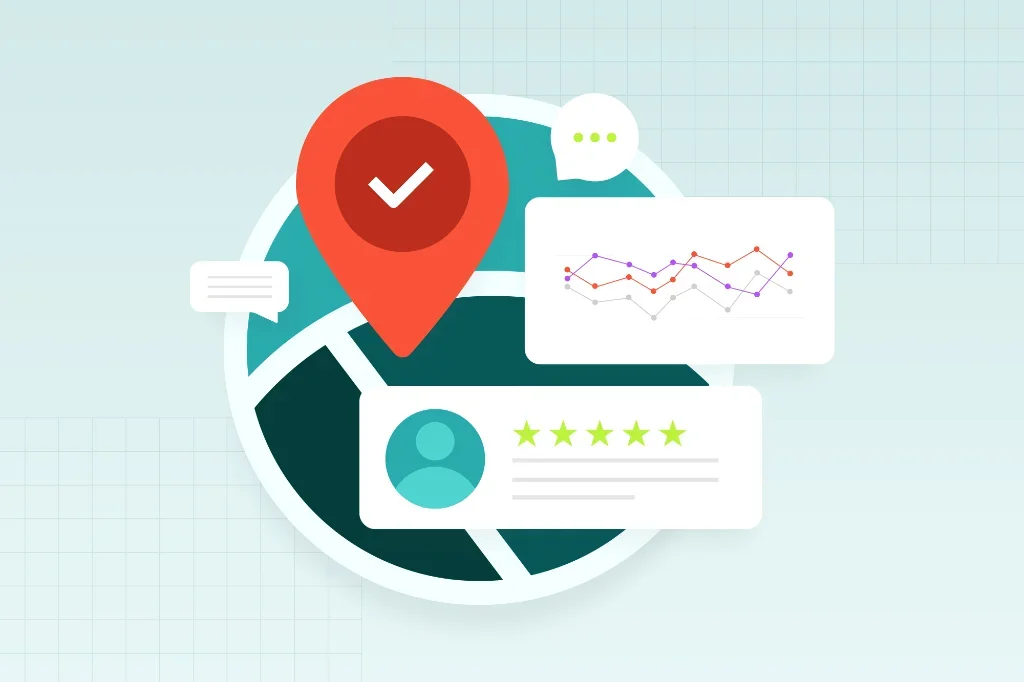Want to grow your business without constantly paying for ads? SEO helps you claim prime real estate in search results to drive sustainable growth that doesn’t disappear when you stop paying. You don’t need a computer science degree or massive budget to get long-lasting SEO ROI. With consistent execution of the basics—finding what your customers search for, creating helpful content, and structuring your site properly—you’ll see compounding results month after month, whether you’re a local service, e-commerce store, or B2B company.
Understanding SEO Fundamentals
What is SEO?
Search Engine Optimization (SEO) is all about improving your website so that it shows up more prominently when people use search engines like Google or Bing. When someone searches for something related to your business or services, a strong SEO approach helps ensure your site is one of the first they see—bringing more visibility and potential customers your way. Or, in technical terms, it’s the process of fine-tuning your site to rank higher in Search Engine Results Pages (SERPs) for relevant queries.
SEO consists of three main areas: making sure your website works smoothly (the technical side), creating content that genuinely helps people, and building credibility online. With these fundamentals in place, your site becomes one that search engines are eager to recommend.
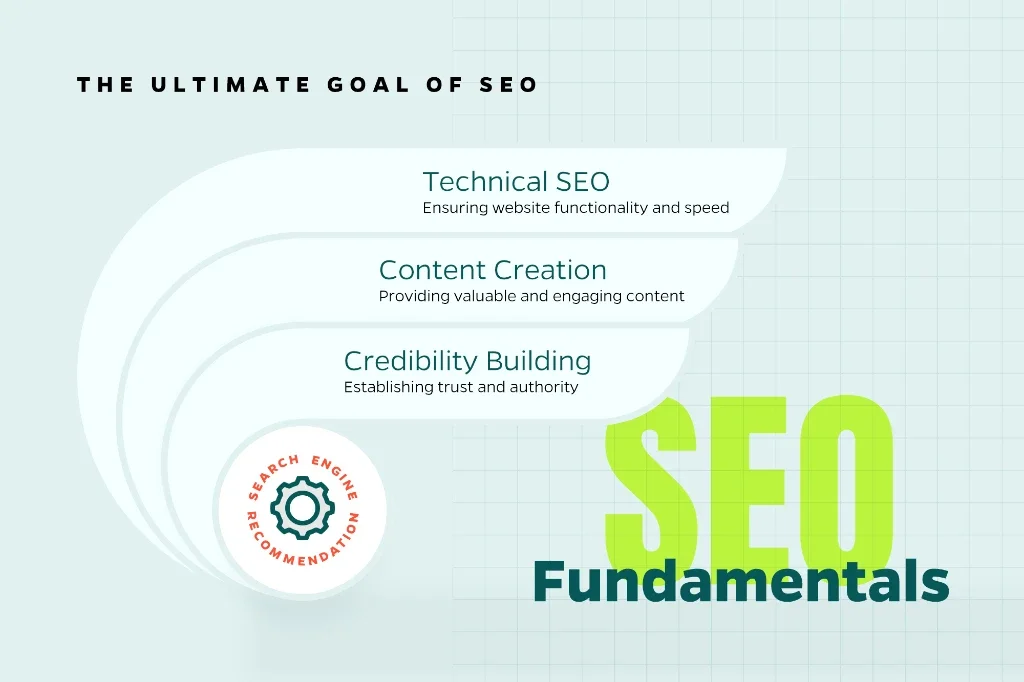
Think of SEO as the digital bridge that connects your business to potential customers. Let’s say someone searches for “best coffee shop near me” or “affordable accounting services.” SEO puts your business in front of people at that perfect moment—when they’re actively searching for your services.
Why SEO Matters for Businesses
Think of SEO as your business’s best long-term investment. While throwing money at paid advertising might give you instant results, it’s like renting visibility. When you stop paying, you disappear. SEO, on the other hand, is like buying property in the digital world. It takes time to build, but once you establish your presence, it keeps delivering value month after month, year after year.
Here’s what makes SEO so powerful for businesses:
- Increased Visibility: When you rank higher, more people discover your business when they’re searching for your product or services. It’s like owning a prime storefront on the busiest street in town.
- Credibility and Trust: There’s an unspoken rule online: if search engines trust you, customers will too. High rankings automatically boost your reputation.
- Cost-Effective Marketing: Once your site ranks organically, every click is free. Compare that to paid ads where literally every visitor costs you money.
- Long-Term Growth: SEO builds momentum over time. The work you do today compounds, creating a snowball effect that gets stronger with each passing month.
For small businesses or those in competitive industries, SEO levels the playing field, allowing you to compete with larger players without breaking the bank.
Core Components of a Basic SEO Strategy
A successful SEO strategy rests on several interconnected pillars. Let’s dive into each one and explore how they work together to boost your online presence.
A. Understanding Your Audience and Their Search Intent
The heart of SEO is understanding your audience. Who are your ideal customers? What challenges do they face, and how can your business solve them? For example, if you run a plumbing service, your audience might be homeowners searching for “emergency plumber near me” or “how to fix a leaky faucet.” By identifying their needs, you can create content that aligns with their search intent.
People tend to search for three main reasons:
- Navigational: They already know where they want to go (like typing “Facebook” to get to Facebook).
- Informational: They’re looking for answers, explanations, or how-to guidance (like “what causes low water pressure”).
- Transactional: They’re ready to buy, hire, or act (like “hire emergency plumber tonight”).
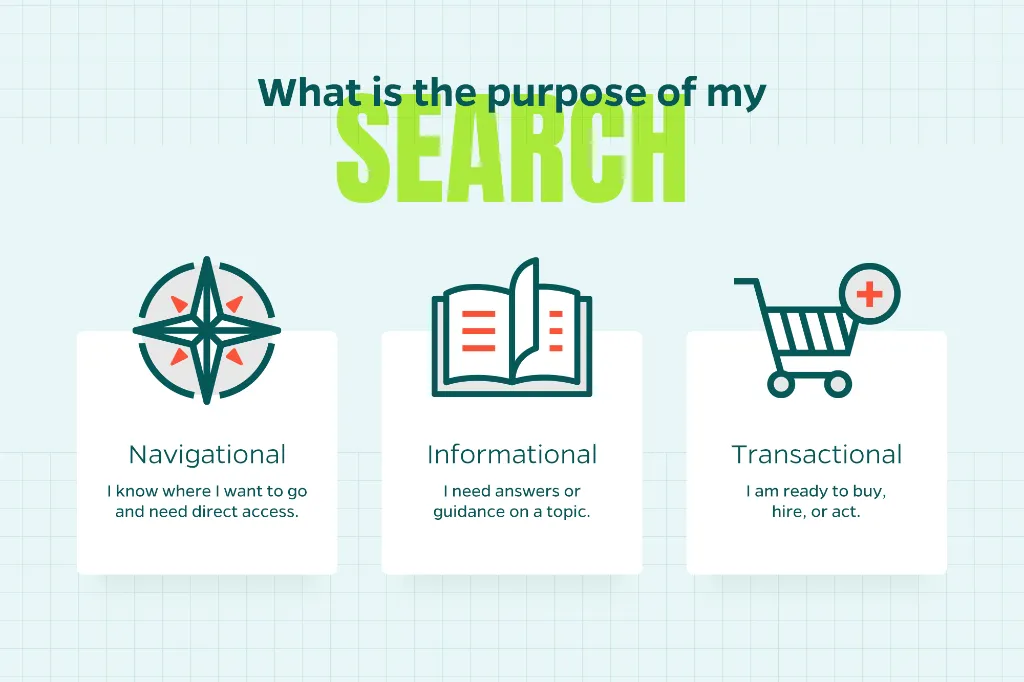
Here’s the key: different types of content work for different intentions. When someone searches “how to unclog a drain,” they want helpful information, not a sales pitch. But when they search “24-hour plumber near me,” they’re ready to make a call. Match your content to their mindset, and you’ll connect with people at exactly the right moment in their journey.
B. Keyword Research
Keywords are the foundation of SEO—they’re the phrases your audience types into search engines. Effective keyword research involves finding terms that are relevant to your business, have sufficient search volume, and aren’t so competitive that ranking is impossible. Here’s how to get started:
- Use Free Tools: Start with Google Keyword Planner and pay attention to Google’s autocomplete suggestions when you type in your search bar. Those suggestions are real searches people are making. Free versions of tools like Semrush or Ahrefs can give you even more insight without breaking the budget.
- Balance the Metrics: You want keywords that have enough people searching for them to matter but aren’t so popular that you’re competing with Amazon and Wikipedia. “Best running shoes” might be a losing battle, but “best running shoes for flat feet” could be your sweet spot.
- Focus on Intent: Remember those three types of search intent (navigational, informational, transactional)? Pick keywords that match what you’re trying to accomplish. A local bakery might go after “best cupcakes in Chicago” to capture buyers, or “how to decorate cupcakes” to attract people who might become customers later.
- Embrace Semantic Search: Google’s algorithms now understand context and related terms. Instead of obsessing over exact-match keywords, incorporate related phrases and synonyms to make your content more natural and relevant.
Here’s a real example: if you own a local coffee shop, you might target the broader “best coffee shop” but also get specific with “organic coffee beans downtown” or “coffee shop with Wi-Fi near university.” Start small with 5-10 carefully chosen keywords rather than trying to rank for everything at once. Quality beats quantity every time.
C. On-Page SEO
On-page SEO involves optimizing the elements on your website to make it both search-engine-friendly and user-focused. Here are the key areas to tackle:
- Title Tags: These are the clickable headlines in search results—your first impression and biggest opportunity to grab attention. Keep them under 60 characters and include your primary keyword to make them compelling. Instead of “Services,” try “Top SEO Tips for Small Businesses in 2025.”
- Meta Descriptions: Think of these as your elevator pitch in search results. You’ve got 160 characters to convince someone your page is worth their time. Use your keywords naturally and focus on benefits: “Learn simple SEO strategies to boost your site’s rankings and attract more customers.”
- Headers (H1, H2, H3): Structure your content with clear headers that include keywords and guide readers through your page. Obviously, you want to include your keywords in headers when it makes sense, but you should prioritize clarity over keyword stuffing.
- High-Quality Content: Mediocre content gets mediocre results. Write high-quality content that helps people solve problems or learn something new. If you wouldn’t bookmark it yourself, it’s probably not good enough.
- URL Structure: Keep your URLs clean and descriptive—think “yoursite.com/seo-tips” instead of “yoursite.com/page123.” If a human can’t figure out what the page is about from the URL, neither can Google.
- Internal Linking: Link to related pages on your site. This gives users a tour of your best content and signals to search engines how your content is connected.
- Structured Data (Schema Markup): Add schema to help search engines understand your content, potentially earning rich snippets like star ratings or FAQs in search results.
Here’s how it all comes together. Imagine you’re a web design agency creating a service page. Your title tag might be “Custom Web Design Services for Small Businesses.” Your meta description could highlight your quick turnaround and local expertise, and your headers might walk through your design process step by step. Then you’d link to relevant case studies and blog posts about current design trends. Every element works together to create a page that both search engines and potential clients can’t ignore.

D. Off-Page SEO
Off-page SEO is all about building your website’s reputation beyond its own borders. The main goal? Earn trust and authority in the eyes of search engines—primarily through backlinks. These are links from other websites that point to yours, acting like digital votes of confidence. The more high-quality sites that link to you, the more credible your site appears.
Here’s how to build those valuable connections:
- Guest Posting: Write genuinely helpful articles for industry blogs and websites. The key word here is “helpful”—nobody wants fluff content just to get a link. Offer real value, and the link becomes a natural bonus.
- Partnerships: Team up with complementary businesses or local organizations. A coffee shop might partner with a local bookstore for cross-promotion, earning authentic links and real relationships.
- Manage Online Reputation: Encourage happy customers to leave reviews and keep an eye on brand mentions across the web.
For example, a local restaurant might partner with a food blogger for a review or contribute a recipe to a community website. This earns both exposure and a valuable backlink.
E. Technical SEO
Technical SEO might sound intimidating, but it’s simply about making sure your website is easy for search engines to crawl, index, and understand. While it sounds complex, the basics are manageable.
Focus on these areas:
- Crawlability and Indexability: Set up a robots.txt file to guide search engines around your site and submit an XML sitemap through Google Search Console. It’s like giving Google a map of your website.
- Site Speed: Nobody likes waiting for slow pages to load—not your visitors and not search engines. Compress images, clean up your code, and enable caching. Google PageSpeed Insights will show you exactly what needs fixing.
- Mobile-Friendliness: Your site needs to work flawlessly on phones and tablets. With mobile-first indexing, Google looks at your mobile version first, so this isn’t optional anymore.
- Canonical Tags: Prevent duplicate content confusion by telling search engines which version of a page is the “official” one. It’s like putting up a sign that says, “This is the real deal.”
- HTTPS: Secure your site with an SSL certificate to protect users and boost rankings.
- Tools: Google Search Console is a free, powerful tool for monitoring technical health, identifying crawl errors, and tracking indexed pages.
A slow site with broken links or duplicate pages can frustrate users and tank your rankings. Regular checkups with tools like Screaming Frog can keep everything running smoothly.
F. Content Creation
Content is the backbone of SEO. It’s how you attract, engage, and convert your audience. Here’s how to make it work:
- Address Audience Needs: Create blog posts, service pages, or videos that solve problems or answer questions. For example, a financial advisor might write a guide on “How to Save for Retirement” to attract informational searches.
- Focus on Quality: Google’s E-E-A-T (Experience, Expertise, Authoritativeness, Trustworthiness) framework rewards content that demonstrates credibility. Include author bios, cite reputable sources, and showcase your expertise.
- Be Consistent: Regular updates keep your site fresh and show search engines you’re actively engaged. A content calendar can help you plan around keyword clusters and seasonal trends.
- Diversify Content Types: Use blog posts for education, service pages for conversions, and sprinkle in videos, infographics, or FAQs to keep things engaging.
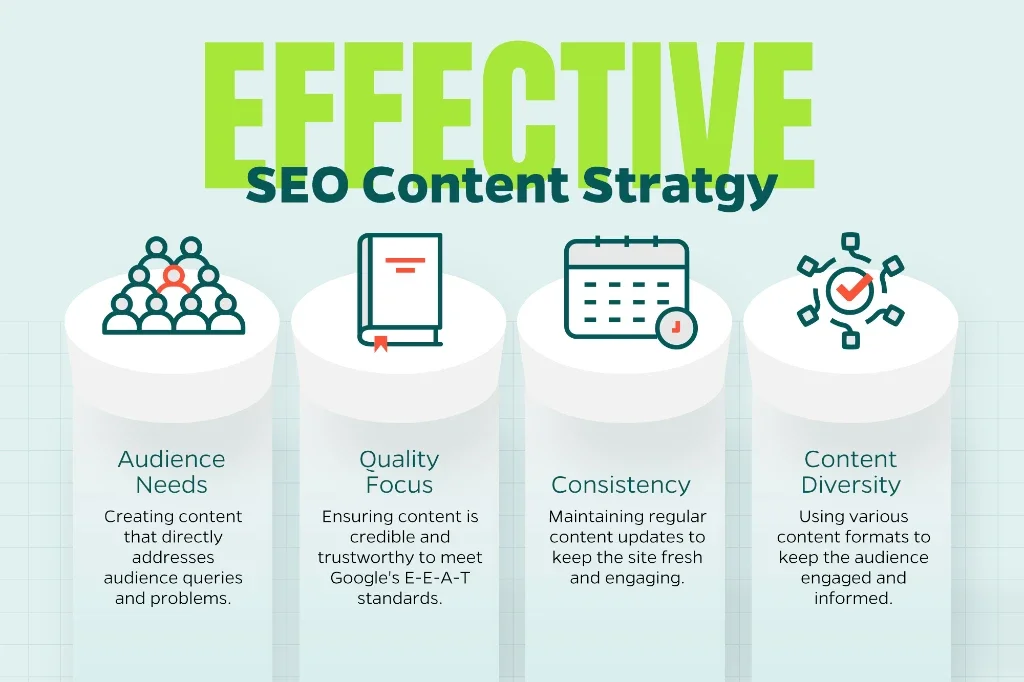
For instance, a home improvement company could publish a “DIY Home Repairs” blog series to attract traffic, then link to service pages for professional help—turning readers into leads.
G. User Experience (UX)
User experience isn’t just about aesthetics—it’s about making your site intuitive, fast, and enjoyable to use. A great UX keeps visitors engaged and conveys quality to search engines.
Key elements include:
- Site Architecture: Organize content and navigation into logical categories. For example, group all plumbing services under one section.
- Mobile Optimization: Ensure buttons, text, and images are easy to interact with on smaller screens.
- Page Speed: Fast-loading pages reduce bounce rates and improve rankings.
- Internal Linking: Use descriptive anchor text like “learn more about our SEO services” instead of vague phrases like “click here.” Help both users and search engines understand what they are clicking on.
A well-designed site not only ranks better but also encourages visitors to explore, engage, and convert.
Common Pitfalls to Avoid
Even well-intentioned SEO efforts can backfire. Here are the mistakes that trip up most businesses and how to avoid them:
- Keyword Stuffing: Cramming keywords into every sentence makes your content unreadable and can hurt your rankings. Write for humans first—search engines are smart enough to understand natural language.
- Misinterpreting User Intent: If your content doesn’t match what users are searching for, they’ll leave quickly. For example, a page optimized for “buy laptops” should focus on products, not general laptop history.
- Neglecting Technical Issues: Broken links, slow pages, or crawl errors can tank your rankings. Regular audits with tools like Google Search Console can catch these issues early.
- Ignoring Mobile: With mobile-first indexing, a site that doesn’t work on phones will struggle to rank anywhere. Test your site on multiple devices regularly.
- Poor Linking Structure: Pages with no internal links (orphaned pages) or generic anchor text like “click here” confuse both search engines and users. Use descriptive, keyword-rich links that help navigation.
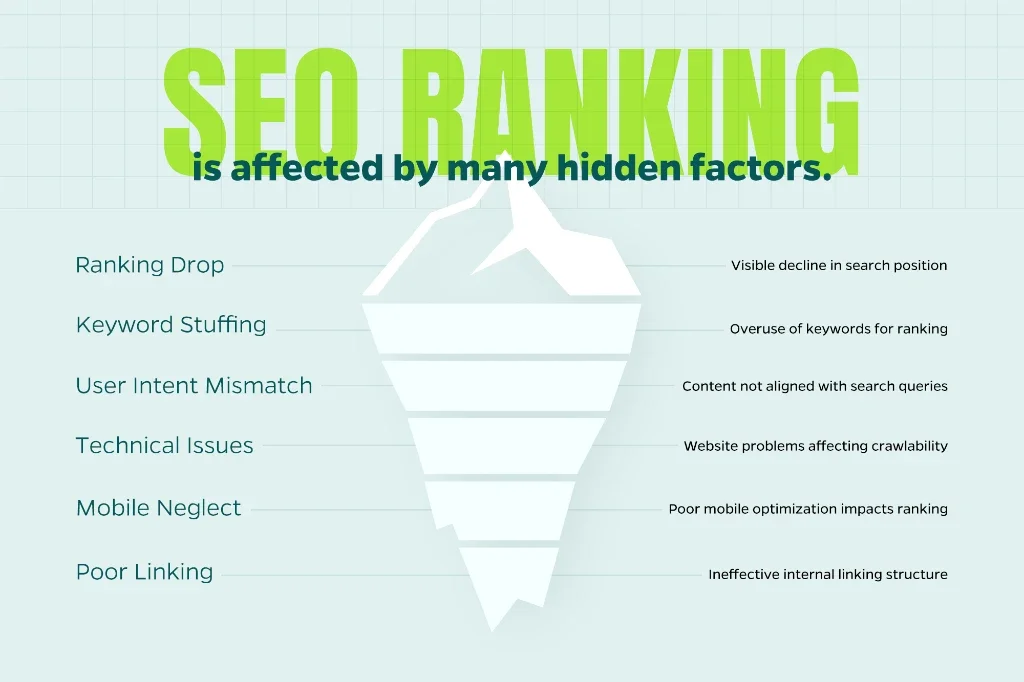
Setting Realistic Goals and Expectations
Defining SEO Success
Success in SEO looks different for every business. Are you trying to generate more leads? Increase online sales? Build brand awareness? Your SEO strategy should align with what moves the needle for your bottom line. Clear goals make it easier to measure progress and prove that your SEO investment is working.
Timeline for Results
SEO is a long-term strategy. While minor improvements (like fixing technical issues) can show results in weeks, significant ranking and traffic gains typically take 3-6 months—especially for new websites or competitive industries. Small-to-medium-sized businesses should focus on low-competition keywords and local SEO to see faster results. Managing expectations is key—SEO is a marathon, not a sprint.
Key Metrics to Track
Tracking the right metrics helps you gauge your progress, refine your strategy, and prove ROI. Here’s a breakdown of some of the most important metrics:
- Visibility & Ranking Metrics:
- Organic Impressions: Found in Google Search Console or Bing Webmaster Tools, you will see how often your site appears in search results, indicating your potential reach.
- Keyword Rankings: Use tools like Semrush, Ahrefs, or Moz to track your position in SERPs for target keywords. Improving rankings is a key milestone.
- Search Visibility/Share of Voice: Advanced tools estimate your share of clicks for tracked keywords, showing your prominence compared to competitors.
- Indexed Pages: Check Google Search Console or Bing Webmaster Tools to ensure your content is discoverable by search engines.
- Organic Traffic Metrics:
- Organic Traffic (Clicks): Measure visits from unpaid search results in Google Analytics 4 (GA4), Search Console, or Bing Webmaster Tools. This is a direct measure of SEO success.
- Organic Click-Through Rate (CTR): Found in Google Search Console or Bing Webmaster Tools, this shows the percentage of users who click your listing. Optimize titles and meta descriptions to boost CTR.
- New Users from Organic Search: Track in GA4 or Bing Webmaster Tools to measure audience growth.
- User Engagement & Behavior Metrics:
- Bounce Rate: Found in GA4 and Microsoft Clarity, this shows the percentage of visitors who leave after viewing one page. A high bounce rate on content pages may indicate a mismatch with user intent.
- Average Session Duration/Engagement Time: Longer sessions in GA4 suggest users find your content valuable.
- Pages Per Session: Higher numbers in GA4 indicate strong navigation and engagement.
- Core Web Vitals: Use Search Console or Lighthouse to monitor Largest Contentful Paint (LCP), Interaction to Next Paint (INP), and Cumulative Layout Shift (CLS). These metrics impact rankings and user satisfaction.
- Conversion & Business Impact Metrics:
- Organic Conversions: Track actions like purchases, form submissions, or downloads in GA4 to measure ROI.
- Organic Conversion Rate: Calculate in GA4 to assess how effectively your traffic converts.
- Organic Revenue/Lead Value: Tie SEO to business outcomes by tracking revenue (for ecommerce) or lead value (for lead-gen) in GA4 or a CRM.
- Traffic Cost (Estimated): Tools like Semrush estimate how much you’d pay for your organic traffic via paid ads, highlighting SEO’s cost savings.
- Authority Metrics:
- Referring Domains/Backlinks: Track with SEO tools to measure the quality and quantity of sites linking to you.
- Domain Authority (DA)/Domain Rating (DR): Moz’s DA or Ahrefs’ DR provides a benchmark for your site’s ranking potential compared to competitors.
Actionable Steps to Get Started
Ready to dive into SEO? Here’s a step-by-step plan to kick things off:
- Conduct a Website Audit: Use free tools like Google Search Console, Bing Webmaster Tools, Screaming Frog, or Lighthouse to identify technical issues, broken links, and content gaps. Fix critical errors first, like slow pages or crawl issues.
- Build a Keyword List: Research 5-10 high-priority keywords using Google Keyword Planner or similar tools. Focus on high-intent, low-competition terms relevant to your business.
- Optimize Key Pages: Start with your homepage, service pages, and high-traffic blog posts. Update title tags, meta descriptions, headers, and content to align with your keywords and user intent.
- Create a Content Calendar: Plan regular content updates around keyword clusters and seasonal trends. For example, a retailer might create holiday gift guides or back-to-school content to capture timely searches.
- Monitor and Adjust: Use tools like Google Analytics 4 and Search Console to track metrics such as organic traffic, CTR, and conversions. Review data monthly to refine your strategy and address underperforming areas.
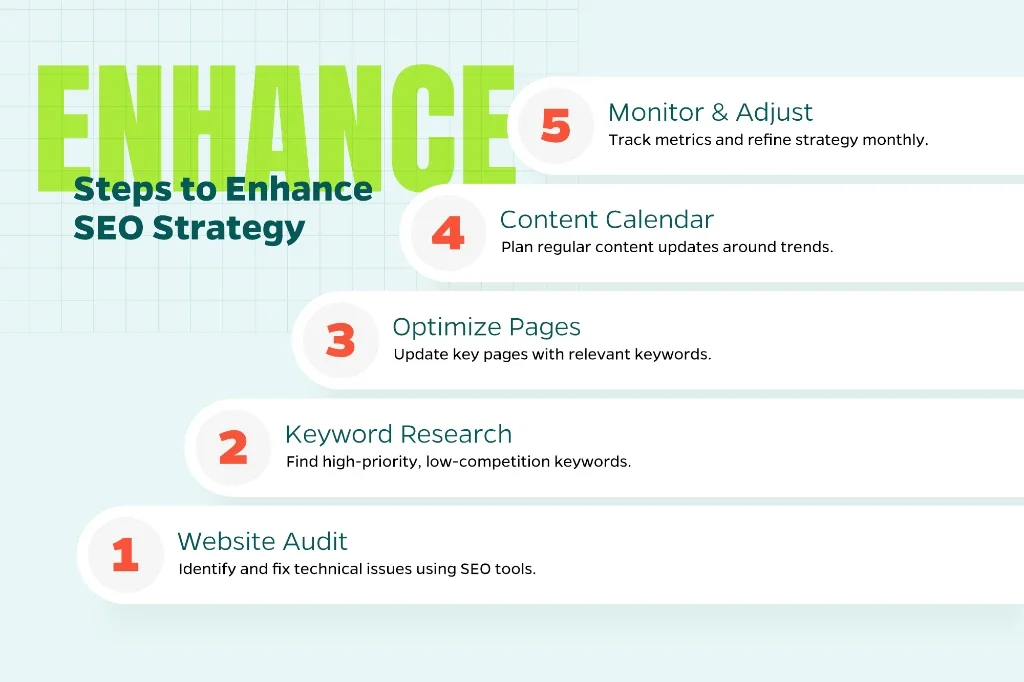
Conclusion
At Straight North, we view SEO as a long-term strategy—not a quick fix. Begin with the foundational steps above, stay consistent, and watch your digital visibility grow steadily over time. Want to level up your efforts? Dive into our blog, where you’ll find actionable SEO strategies, recommended tools, and smart tips to sidestep common pitfalls. Your journey to stronger rankings and more qualified traffic begins now. Take the first step and see where it takes you.



